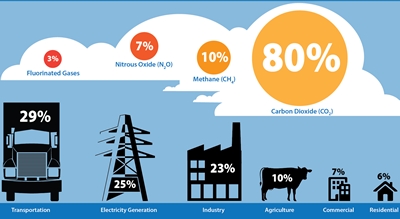EPA says GHGs Down 1.7% in 2019 and Down 13% from 2005
Date: April 14, 2021
Source: U.S. Environmental Protection Agency (EPA)

EPA's latest Inventory of U.S. Greenhouse Gas Emissions and Sinks (GHG Inventory) reports that emissions decreased from 2018 to 2019 by 1.7% (after accounting for sequestration from the land sector). This was attributed to decreased fossil fuel combustion from decreased energy use, and a continued shift from coal to natural gas and renewables in the electric power sector. CO2 emissions alone decreased 2.2%, and those from fossil fuel combustion decreased 2.7% during that timeframe. GHG emissions were 13% below 2005 levels and up only 1.8% from 1990 levels.
Transportation activities are the largest source of emissions, accounting for 29% of total US greenhouse gas emissions in 2019. From 1990 to 2019, transportation CO2 emissions from fossil fuel combustion rose by 24% due in large part to increased demand for travel. The number of vehicle miles traveled by light-duty vehicles (i.e., passenger cars and light-duty trucks) increased by 48% from 1990 to 2019; those by medium- and heavy-duty trucks increased 109% over the same period. Significant improvements in average new vehicle fuel economy since 2005 has slowed the rate of increase of CO2 emissions.
PRESS RELEASE
April 14, 2021
EPA Publishes 28th Annual U.S. Greenhouse Gas Inventory
WASHINGTON (April 14, 2021) — Today, the U.S. Environmental Protection Agency (EPA) released its 28th annual Inventory of U.S. Greenhouse Gas Emissions and Sinks (GHG Inventory), which presents a national-level overview of annual greenhouse gas emissions from 1990 to 2019. Net U.S. greenhouse gas emissions were 5,769 million metric tons of carbon dioxide equivalent in 2019, a 1.7 percent decrease in emissions between 2018 and 2019. While many long-term and short-term factors influence annual greenhouse gas emissions in recent years, the downward GHG emissions trend can be largely attributed to falling emissions in the electric power sector.
The GHG Inventory covers seven key greenhouse gases: carbon dioxide, methane, nitrous oxide, hydrofluorocarbons, perfluorocarbons, sulfur hexafluoride, and nitrogen trifluoride. In addition to tracking U.S. greenhouse gas emissions, the inventory also calculates carbon dioxide that is removed from the atmosphere through the uptake of carbon in forests and other vegetation.
This impartial, policy neutral report, has been compiled annually since 1993 and submitted to the United Nations Framework Convention on Climate Change. The report is prepared by EPA in collaboration with numerous experts from other federal agencies, state government authorities, research and academic institutions, and industry associations. Under the United Nations Framework Convention on Climate Change (UNFCCC), national inventories for UNFCCC Annex I parties should be provided to the UNFCCC Secretariat each year by April 15.
In an effort to engage the public and researchers across the country, EPA conducts an annual public review and comment process for this document. The document was made available on the EPA Greenhouse Gas Emissions website and announced via Federal Register Notice for 30 days. Comments received after the closure of the public comment period are accepted and considered for the next edition of this annual report. Public review of this year's report occurred from February 12 to March 15, 2021 and comments received are posted to the docket EPAHQ-OAR-2021-0008. Responses to comments will be posted to EPA's website within 2-4 weeks following publication of this report.
More information on the report: https://www.epa.gov/ghgemissions/inventory-us-greenhouse-gas-emissions-and-sinks.
Contact Information:
EPA Press Office (press@epa.gov)
Sign up to receive our free Weekly News Bulletin